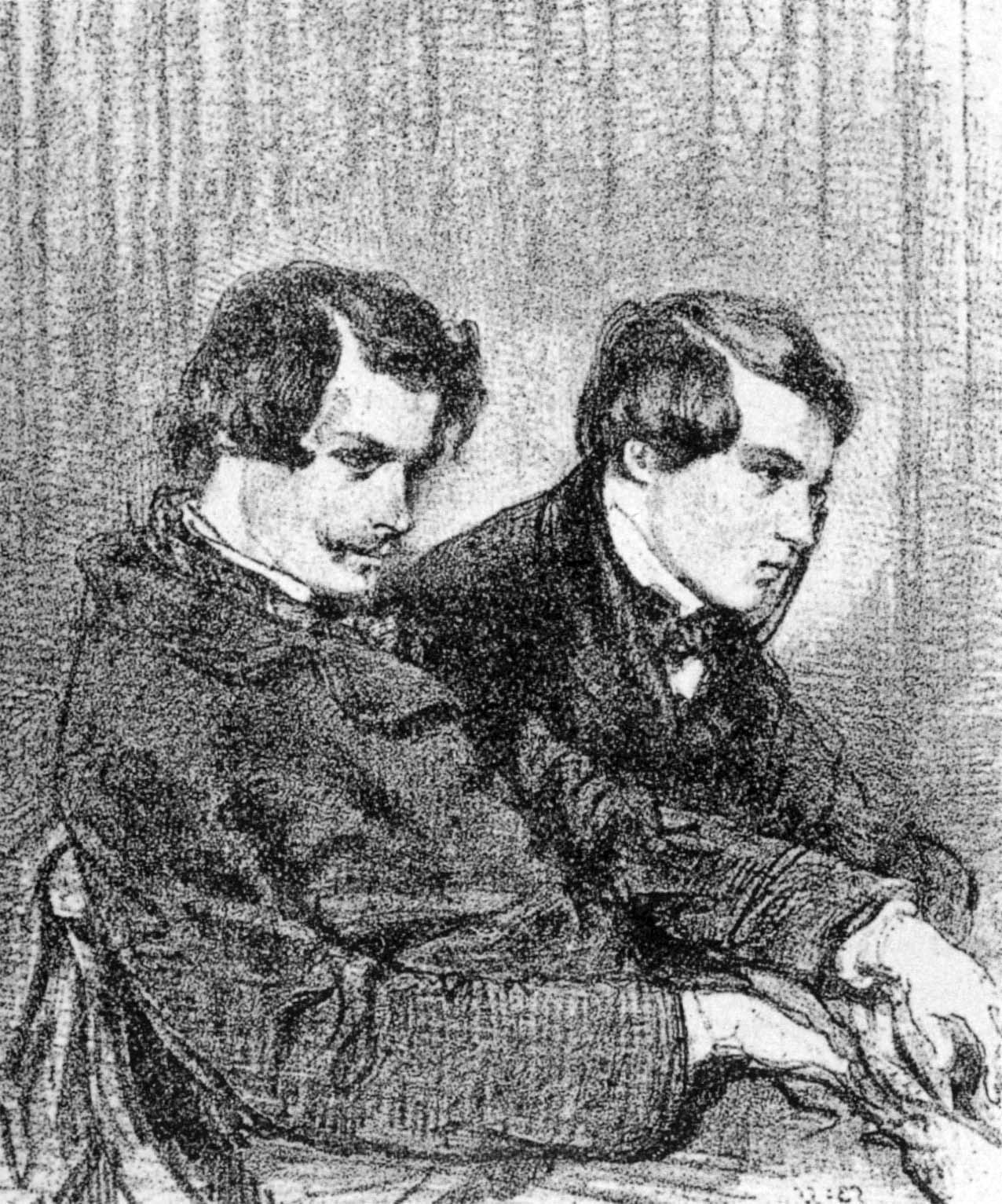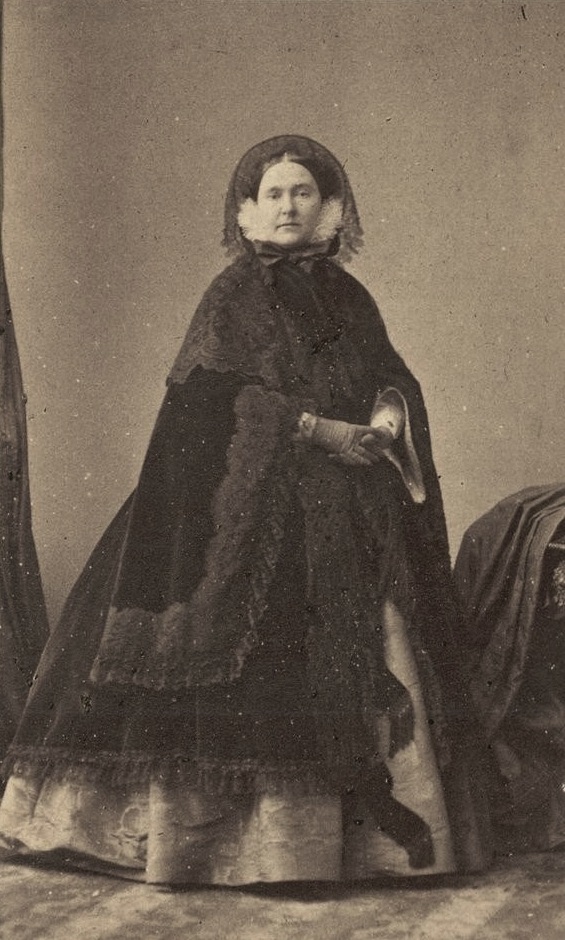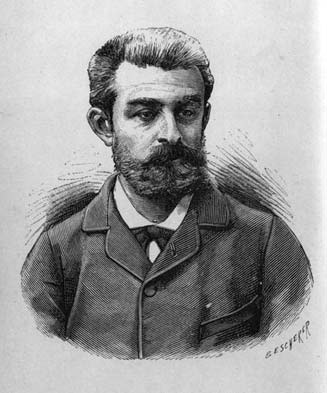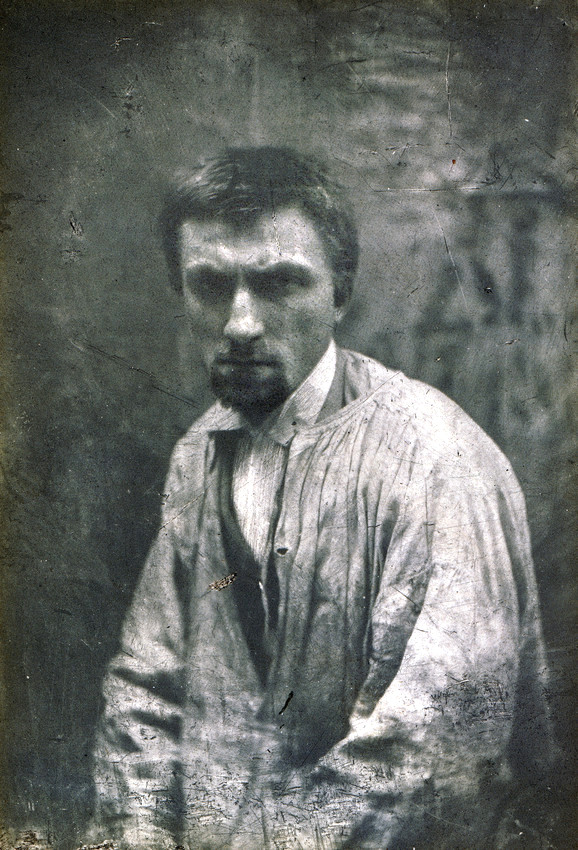|
Goncourt Journal
The Goncourt Journal was a diary written in collaboration by the brothers Edmond and Jules de Goncourt from 1850 up to Jules' death in 1870, and then by Edmond alone up to a few weeks before his own death in 1896. It forms an unrivalled and entirely candid chronicle of the literary and artistic Parisian world in which they lived; "a world", it has been said, "of bitter rivalries and bitterer friendships, in which every gathering around a café table on the Grands Boulevards asa chance to raise one's status in the byzantine literary hierarchy". Fear of lawsuits by the Goncourts' friends and their heirs prevented publication of anything but carefully chosen selections from the Journal for many years, but a complete edition of the original French text appeared in the 1950s in 22 volumes, and there have been several selective translations into English. The process of collaboration The Goncourt brothers formed a very close literary partnership. Not only were all of their novels, dra ... [...More Info...] [...Related Items...] OR: [Wikipedia] [Google] [Baidu] |
Goncourt
The Goncourt brothers (, , ) were Edmond de Goncourt (1822–1896) and Jules de Goncourt (1830–1870), both French naturalism writers who, as collaborative sibling authors, were inseparable in life. Background Edmond and Jules were born to minor aristocrats Marc-Pierre Huot de Goncourt and his second wife Annette-Cécile de Goncourt (née Guérin). Marc-Pierre was a retired cavalry officer and squadron leader in the Grande Armée of Napoléon I. The brothers' great-grandfather, Antoine Huot de Goncourt, purchased the ''seigneurie'' of the village of Goncourt in the Meuse Valley in 1786, and their grandfather Huot sat as a deputy in the National Assembly of 1789. The brothers' uncle, Pierre Antoine Victor Huot de Goncourt, was a deputy for the Vosges in the National Assembly between 1848 and 1851. In 1860, the brothers applied to the Keeper of the Seals for the exclusive use of the noble title "de Goncourt", but their claim was refused. Partnership They formed a partnership ... [...More Info...] [...Related Items...] OR: [Wikipedia] [Google] [Baidu] |
Mathilde Bonaparte
Mathilde Laetitia Wilhelmine Bonaparte, Princesse Française, Princess of San Donato (27 May 1820 – 2 January 1904), was a French princess and salonnière. She was a daughter of Napoleon's brother Jérôme Bonaparte and his second wife, Catharina of Württemberg, daughter of King Frederick I of Württemberg. Biography Born in Trieste, Mathilde Bonaparte was raised in Florence and Rome. She was originally engaged to her first cousin, the future Napoleon III of France, but the engagement was cancelled following his imprisonment at Ham. She married a rich Russian nobleman, Anatoly Nikolaievich Demidov, 1st Prince of San Donato, on November 1, 1840 in Rome. Anatole was raised to the position of ''Prince'' by Grand Duke Leopold II of Tuscany shortly before the wedding to fulfill the wishes of Mathilde's father and to preserve Mathilde's position as ''Princess''. Anatole's princely title was never recognised in Russia. They had no children. The marriage between these two stron ... [...More Info...] [...Related Items...] OR: [Wikipedia] [Google] [Baidu] |
Joris-Karl Huysmans
Charles-Marie-Georges Huysmans (, ; 5 February 1848 – 12 May 1907) was a French novelist and art critic who published his works as Joris-Karl Huysmans (, variably abbreviated as J. K. or J.-K.). He is most famous for the novel ''À rebours'' (1884, published in English as ''Against the Grain'' and as ''Against Nature''). He supported himself by way of a 30-year career in the French civil service. Huysmans's work is considered remarkable for its idiosyncratic use of the French language, large vocabulary, descriptions, satirical wit and far-ranging erudition. First considered part of Naturalism, he became associated with the decadent movement with his publication of ''À rebours.'' His work expressed his deep pessimism, which had led him to the philosophy of Arthur Schopenhauer. In later years, his novels reflected his study of Catholicism, religious conversion, and becoming an oblate. He discussed the iconography of Christian architecture at length in '' La cathédral ... [...More Info...] [...Related Items...] OR: [Wikipedia] [Google] [Baidu] |
Hippolyte Taine
Hippolyte Adolphe Taine (, 21 April 1828 – 5 March 1893) was a French historian, critic and philosopher. He was the chief theoretical influence on French naturalism, a major proponent of sociological positivism and one of the first practitioners of historicist criticism. Literary historicism as a critical movement has been said to originate with him. Taine is also remembered for his attempts to provide a scientific account of literature. Taine had a profound effect on French literature; the 1911 ''Encyclopædia Britannica'' asserted that ''"the tone which pervades the works of Zola, Bourget and Maupassant can be immediately attributed to the influence we call Taine's."'' Out of the trauma of 1871, Taine has been said by one scholar to have ‘forged the architectural structure of modern French right-wing historiography’. Early years Taine was born in Vouziers into a fairly prosperous Ardennes family. His father, a lawyer, his uncle, and his grandfather encouraged him t ... [...More Info...] [...Related Items...] OR: [Wikipedia] [Google] [Baidu] |
Ernest Renan
Joseph Ernest Renan (; 27 February 18232 October 1892) was a French Orientalist and Semitic scholar, expert of Semitic languages and civilizations, historian of religion, philologist, philosopher, biblical scholar, and critic. He wrote influential and pioneering historical works on the origins of early Christianity, and espoused popular political theories especially concerning nationalism and national identity. Renan is known as being among the first scholars to advance the now-discredited Khazar theory, which held that Ashkenazi Jews were descendants of the Khazars, Turkic peoples who had adopted Jewish religion and migrated to Western Europe following the collapse of their khanate. Life Birth and family He was born at Tréguier in Brittany to a family of fishermen. His grandfather, having made a small fortune with his fishing smack, bought a house at Tréguier and settled there, and his father, captain of a small cutter and an ardent republican, married the daughter of a ... [...More Info...] [...Related Items...] OR: [Wikipedia] [Google] [Baidu] |
Victor Hugo
Victor-Marie Hugo (; 26 February 1802 – 22 May 1885) was a French Romantic writer and politician. During a literary career that spanned more than sixty years, he wrote in a variety of genres and forms. He is considered to be one of the greatest French writers of all time. His most famous works are the novels ''The Hunchback of Notre-Dame'' (1831) and ''Les Misérables'' (1862). In France, Hugo is renowned for his poetry collections, such as (''The Contemplations'') and (''The Legend of the Ages''). Hugo was at the forefront of the Romanticism, Romantic literary movement with his play ''Cromwell (play), Cromwell'' and drama ''Hernani (drama), Hernani''. Many of his works have inspired music, both during his lifetime and after his death, including the opera ''Rigoletto'' and the musicals ''Les Misérables (musical), Les Misérables'' and ''Notre-Dame de Paris (musical), Notre-Dame de Paris''. He produced more than 4,000 drawings in his lifetime, and campaigned for social cau ... [...More Info...] [...Related Items...] OR: [Wikipedia] [Google] [Baidu] |
Charles Baudelaire
Charles Pierre Baudelaire (, ; ; 9 April 1821 – 31 August 1867) was a French poetry, French poet who also produced notable work as an essayist and art critic. His poems exhibit mastery in the handling of rhyme and rhythm, contain an exoticism inherited from Romantics, but are based on observations of real life. His most famous work, a book of lyric poetry titled ''Les Fleurs du mal'' (''The Flowers of Evil''), expresses the changing nature of beauty in the rapidly industrializing Paris during the mid-19th century. Baudelaire's highly original style of prose-poetry influenced a whole generation of poets including Paul Verlaine, Arthur Rimbaud and Stéphane Mallarmé, among many others. He is credited with coining the term modernity (''modernité'') to designate the fleeting, ephemeral experience of life in an urban metropolis, and the responsibility of artistic expression to capture that experience. Marshall Berman has credited Baudelaire as being the first Modernism, Modernis ... [...More Info...] [...Related Items...] OR: [Wikipedia] [Google] [Baidu] |
Heinrich Heine
Christian Johann Heinrich Heine (; born Harry Heine; 13 December 1797 – 17 February 1856) was a German poet, writer and literary critic. He is best known outside Germany for his early lyric poetry, which was set to music in the form of '' Lieder'' (art songs) by composers such as Robert Schumann and Franz Schubert. Heine's later verse and prose are distinguished by their satirical wit and irony. He is considered a member of the Young Germany movement. His radical political views led to many of his works being banned by German authorities—which, however, only added to his fame. He spent the last 25 years of his life as an expatriate in Paris. Early life Childhood and youth Heine was born on 13 December 1797, in Düsseldorf, in what was then the Duchy of Berg, into a Jewish family. He was called "Harry" in childhood but became known as "Heinrich" after his conversion to Lutheranism in 1825. Heine's father, Samson Heine (1764–1828), was a textile merchant. His mother Peira ... [...More Info...] [...Related Items...] OR: [Wikipedia] [Google] [Baidu] |
Auguste Rodin
François Auguste René Rodin (12 November 184017 November 1917) was a French sculptor, generally considered the founder of modern sculpture. He was schooled traditionally and took a craftsman-like approach to his work. Rodin possessed a unique ability to model a complex, turbulent, and deeply pocketed surface in clay. He is known for such sculptures as ''The Thinker'', ''Monument to Balzac'', '' The Kiss'', ''The Burghers of Calais'', and ''The Gates of Hell''. Many of Rodin's most notable sculptures were criticized, as they clashed with predominant figurative sculpture traditions in which works were decorative, formulaic, or highly thematic. Rodin's most original work departed from traditional themes of mythology and allegory. He modeled the human body with naturalism, and his sculptures celebrate individual character and physicality. Although Rodin was sensitive to the controversy surrounding his work, he refused to change his style, and his continued output brought increas ... [...More Info...] [...Related Items...] OR: [Wikipedia] [Google] [Baidu] |
Edgar Degas
Edgar Degas (, ; born Hilaire-Germain-Edgar De Gas, ; 19 July 183427 September 1917) was a French Impressionist artist famous for his pastel drawings and oil paintings. Degas also produced bronze sculptures, prints and drawings. Degas is especially identified with the subject of dance; more than half of his works depict dancers. Although Degas is regarded as one of the founders of Impressionism, he rejected the term, preferring to be called a realist,Gordon and Forge 1988, p. 31 and did not paint outdoors as many Impressionists did. Degas was a superb draftsman, and particularly masterly in depicting movement, as can be seen in his rendition of dancers and bathing female nudes. In addition to ballet dancers and bathing women, Degas painted racehorses and racing jockeys, as well as portraits. His portraits are notable for their psychological complexity and their portrayal of human isolation. At the beginning of his career, Degas wanted to be a history painter, a calling f ... [...More Info...] [...Related Items...] OR: [Wikipedia] [Google] [Baidu] |
Charles Augustin Sainte-Beuve
Charles Augustin Sainte-Beuve (; 23 December 1804 – 13 October 1869) was a French literary critic. Early life He was born in Boulogne, educated there, and studied medicine at the Collège Charlemagne in Paris (1824–27). In 1828, he served in the St Louis Hospital. Beginning in 1824, he contributed literary articles, the ''Premier lundis'' of his collected ''Works'', to the newspaper ''Globe'', and in 1827 he came, by a review of Victor Hugo's ''Odes et Ballades'', into close association with Hugo and the Cénacle, the literary circle that strove to define the ideas of the rising Romanticism and struggle against classical formalism. Sainte-Beuve became friendly with Hugo after publishing a favourable review of the author's work but later had an affair with Hugo's wife, Adèle Foucher, which resulted in their estrangement. Curiously, when Sainte-Beuve was made a member of the French Academy in 1845, the ceremonial duty of giving the reception speech fell upon Hugo. ... [...More Info...] [...Related Items...] OR: [Wikipedia] [Google] [Baidu] |
Paul Bins, Comte De Saint-Victor
Paul Bins, comte de Saint-Victor (11 July 1827 in Paris – 9 July 1881 in Paris), known as Paul de Saint-Victor, a French author and critic. He is likely most known today as a French cultural figure mentioned by Marcel Proust in the novel ''In Search of Lost Time''. Personal Saint-Victor was born in Paris. His father Jacques Bins, comte de Saint-Victor (1772–1858), is chiefly remembered for his poem ''L'Espérance'', and for an excellent verse translation of Anacreon. He had an affair with Lia Félix, a sister of the famous actress Rachel Félix. They had a girl, Claire, on 26 October 1860, whose godfather was Edmond de Goncourt. Saint-Victor died in Paris on 9 July 1881. Career Saint-Victor ceased using his title as he found it out of keeping with his democratic principles. He began as a drama critic on the ''Pays'' newspaper in 1851, and in 1855 he succeeded Théophile Gautier on the ''Presse''. In 1866 he migrated to the ''Liberté'', and in 1869 joined the staff of the ... [...More Info...] [...Related Items...] OR: [Wikipedia] [Google] [Baidu] |

.jpg)





.jpg)

.jpg)
